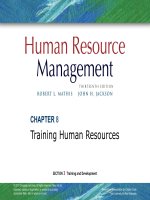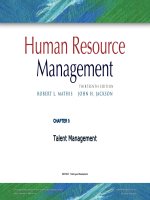Human resrouce management 12th mathis jacson chapter 001
Bạn đang xem bản rút gọn của tài liệu. Xem và tải ngay bản đầy đủ của tài liệu tại đây (1.49 MB, 24 trang )
CHAPTER 1
Changing Nature of Human
Resource Management
© 2008 Thomson/South-Western All rights reserved.
PowerPoint Presentation by Charlie Cook
The University of West Alabama
Chapter
Chapter Objectives
Objectives
After you have read this chapter, you should be able to:
■ Define human capital and explain its importance.
■ Identify the seven categories of HR activities.
■ Describe how the major roles of HR management are
being transformed.
■ Discuss four challenges facing HR today.
■ Identify the purposes and uses of HR technology.
■ Discuss why ethical issues affect HR management.
■ Explain the key competencies needed by HR
professionals and why certification is important.
© 2008 Thomson/South-
1–2
Nature of Human Resource Management
• Human Resource (HR) Management
Designing management systems to ensure that
human talent is used effectively and efficiently to
accomplish organizational goals.
• Who Is an HR Manager?
In the course carrying out their duties, every operating
manager is, in essence, an HR manager.
HR specialists design processes and systems that
operating managers help implement.
© 2008 Thomson/South-
1–3
Types of Organizational Assets
Assets
Physical
Financial
© 2008 Thomson/South-
Intangible
Human
1–4
Human Capital in Organizations
Human Capital
Core Competency
The collective value of the
capabilities, knowledge,
skills, life experiences, and
motivation of an
organizational workforce.
A unique capability that
creates high value and
differentiates an organization
from its competition.
© 2008 Thomson/South-
1–5
Categories of HR Activities
1. Strategic HR Management
2. Equal Employment Opportunity
3. Staffing
4. HR Development
5. Compensation and Benefits
6. Health, Safety, and Security
7. Employee and Labor Relations
© 2008 Thomson/South-
1–6
FIGURE 1-1
HR Management
Activities
© 2008 Thomson/South-
1–7
Smaller Organizations and HR Management
Issues
Shortage of
Qualified
Workers
Increasing
Costs of
Benefits
© 2008 Thomson/South-
Rising Taxes
Government
Regulation
Compliance
1–8
HR Cooperation with Operating Managers
• HR Unit
• Managers
Develops legal, effective
Advise HR of job openings
interviewing techniques
Decide whether to do own
Trains managers in
conducting selection
interviews
Conducts interviews and
testing
Sends top three applicants
to managers for final review
Checks references
Does final interviewing and
final interviewing
Receive interview training
from HR unit
Do final interviewing and
hiring where appropriate
Review reference
information
Provide feedback to HR unit
on hiring/rejection decisions
hiring for certain job
classifications
© 2008 Thomson/South-
1–9
FIGURE 1-2
Typical Division of HR Responsibilities: Training
© 2008 Thomson/South-
1–10
HR Management Roles
HR Management Roles
Administrative
Operational and
Employee
Advocate
© 2008 Thomson/South-
Strategic
1–11
FIGURE 1-3
Changing Roles of HR Management
Note: Example percentages are based on various surveys.
© 2008 Thomson/South-
1–12
FIGURE 1-4
Performance
Management
Linkage
© 2008 Thomson/South-
1–13
FIGURE 1-5
Fastest Growing Jobs to 2014
Source: U.S. Bureau of Labor Statistics, www.bls.gov.
© 2008 Thomson/South-
1–14
Current HR Management Challenges
Economic and
Technological
Changes
Globalization of
Business
Human
Resource
Management
Workforce
Demographics and
Diversity
© 2008 Thomson/South-
Organizational Cost
Pressures and
Restructuring
1–15
FIGURE 1-6
Family-Friendly Benefit Offerings
Source: Adapted from Benefits Survey Report (Alexandria,
VA: Society for Human Resource Management, 2006).
© 2008 Thomson/South-
1–16
HR Technology
• Human Resource Management System (HRMS)
An integrated system providing information used by
HR management in decision making.
Purposes and Benefits of HRMS
Administrative
Availability
and operational efficiency
of data for HR strategic planning
Automation
of payroll and benefit activities
EEO/affirmative
Cost
action tracking
reductions for HR workflows
© 2008 Thomson/South-
1–17
Uses of a Web-Based HRMS
HRMS on
the Internet
Bulletin
Boards
Data
Access
© 2008 Thomson/South-
Employee
Self-Service
Extended
Linkage
1–18
Ethical Behavior and Organizational Culture
• Organizational Culture
The shared values and beliefs in an organization
• Fostering Ethical Behavior (Sarbanes-Oxley)
Have a written code of ethics and conduct standards
Provide ethical behavior training and advice
Establish confidential reporting systems for ethical
misconduct
Provide whistle-blower protection
Support HR’s role as “keeper and voice” of
organizational ethics
© 2008 Thomson/South-
1–19
FIGURE 1-7
Examples of Ethical Misconduct in HR Activities
Types of Misconduct
Examples of Employee, Supervisor, and Managerial Behavior
Compensation
•
•
•
•
Employee Relations
• Employees lying to supervisors
• Executives/managers providing false information to public,
customers, and vendors
• Personal gains/gifts from vendors
• Misusing/stealing organizational assets and supplies
• Intentionally violating safety/health regulations
Staffing and Equal
Employment
• Favoritism in hiring and promotion
• Sexual harassment
• Sex, race, and age discrimination in hiring, discipline, and
termination
Misrepresenting hours and time worked
Falsifying expense reports
Personal bias in performance appraisals and pay increases
Inappropriate overtime classifications
© 2008 Thomson/South-
1–20
HR Management Competencies
and Careers
Strategic Contribution
Business Knowledge
HR Delivery
HR
Competencies
HR Technology
Personal Credibility
© 2008 Thomson/South-
1–21
HR Management as a Career Field
HR Generalist
A person who has responsibility
for performing a variety of HR
activities.
© 2008 Thomson/South-
HR Specialist
A person who has in-depth
knowledge and expertise in
a limited area of HR.
1–22
FIGURE 1-8
HR Specialists
Source: HR Department Benchmarks and Analysis 2007
(Washington, DC: Bureau of National Affairs, 2007), 131.
To purchase this publication and find out more about BNA
HR solutions, visit or call 800-3721033. Used with permission.
© 2008 Thomson/South-
1–23
FIGURE 1-9
HR Certification
The Human Resource Certification Institute offers three
types of professional certifications for HR generalists.
Details on these certifications are available from the Human Resources Certification Institute, www.hrci.org.
© 2008 Thomson/South-
1–24









